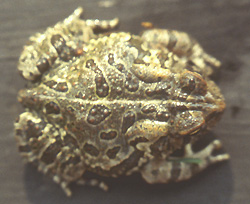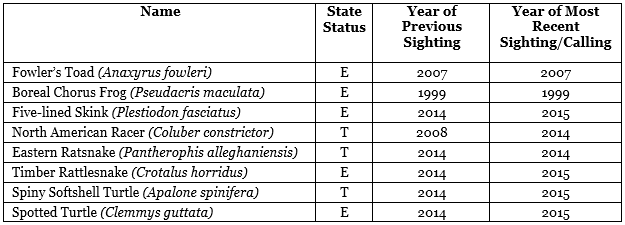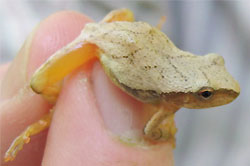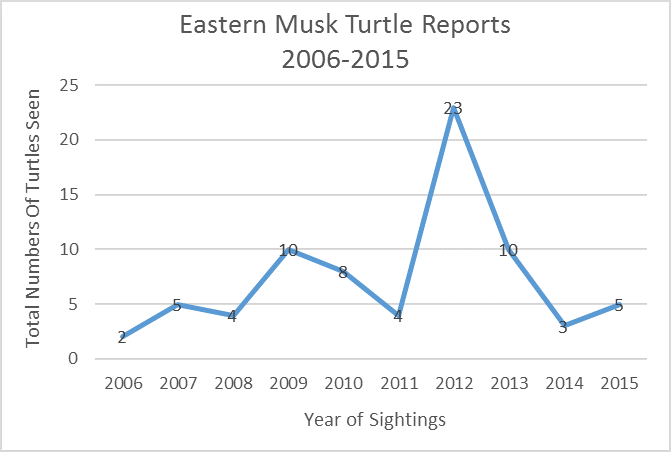Amphibians
Amphibian Monitoring on Mt. Mansfield

Reptiles and amphibians (herps) in Vermont are excellent indicators of environmental change, because they are vulnerable to pollutants, habitat loss and other anthropogenic changes, and because they can only survive in a narrow range of temperature and climate conditions. Road construction is a major source of habitat fragmentation and loss, and roads present a lethal obstacle to migratory amphibians (Sorenson & Osborne, 2014). Changing temperature regimes may take a toll on local herp populations, by changing the abiotic cues on which they rely to prevent exposure to freezing temperatures, and through drought or other effects on hydroperiod (Olson, D.H. and D. Saenz., 2013). Vermont is host to eight species classified by the state as at high risk of extirpation due to rarity. On-going monitoring of both common and rare species will aid in the assessment of changes in their distribution and abundance over time.
The Data
In 2015, VMC was unable to sponsor amphibian population data collection. This year’s section focuses on data collected as part of the statewide, citizen science inventory underpinning the Vermont Reptile and Amphibian Atlas1. Partial funding for the atlas in 2015 was provided by the Lintilhac Foundation and Vermont Department of Fish and Wildlife.
There are eight Vermont reptile and amphibian species classified as rare by state scientists. Sightings are reported by citizen scientists and from searches made regularly by Jim Andrews and other scientists. Identification of changes in the abundance and distribution of these species may indicate changes in the environmental health of the forest and its waters.
2015 in Summary
Winter herpetological activity: Some of the most interesting verified reports of 2015 have been the late season sightings of both reptiles and amphibians. In December of 2015 there were reports of eight species either actively moving or calling during December, and an American Toad was found moving in a yard in Huntington in January. This is the first report of toad activity in January since the beginning of the Atlas over 20 years ago. All of these reports occurred on warm days during an unseasonably warm fall and early winter.
Citizen reports of species are not necessarily consistent enough to use for population level monitoring, but they do tell us if those species are still present in the state. Figure 23 shows a decade of reports to the Atlas for the Eastern Musk turtle, which is a species at risk due to a limited range and few populations.
This represents an average of 7.4 reports/year, from an average of approximately 3 towns/year. If the 18 baby musk turtles sighted as a result of an unusually good nesting season are removed, the trend line is still positive, and the mean number of reports drops to 5.6/year.
Three native species were not reported this year: The state-endangered Fowler’s Toad was last reported in Vermont in 2007, though reports of breeding on Stebbin’s Island in New Hampshire near Vernon, VT have been confirmed. The Boreal Chorus Frog (state-endangered) was last heard in 1999. It has disappeared from the New York portion of the Champlain Valley and much of its habitat in Quebec and eastern Ontario. The North American Racer (state-threatened) was reported in 2008, then again in 2014, but not during 2015.

Additional information on rare species: Fowler’s Toad was officially listed as endangered on March 28, 2016. This would not have occurred without the Reptile and Amphibian Atlas data and support. The recovery plan for the state-endangered Timber Rattlesnake used Atlas data too.
Since 2000 we have had eight well-documented reports of Eastern Box Turtles in the Dover/Putney area of Vermont. The Reptile and Amphibian Scientific Advisory Group (RASAG) discussed the possibility that this might be a native breeding population.
Long Term Trends
There are several reptile and amphibian species whose populations in Vermont are precarious (see Table 8 above). None of these species are present on Mount Mansfield, where a more intensive population survey is conducted, consequently the statewide Atlas is the primary way data on these species are gathered.
Implications
Salamander chytrid is a newly discovered disease that was killing European salamanders and could potentially impact our salamanders (particularly newts) if the disease arrives in the US. The species list includes two common native Vermont species: the Eastern Newt and the Eastern Red-backed Salamander. The Reptile and Amphibian Atlas is the only source of data on those two species in Vermont and it will be this data that will allow us to see and report declines if this pathogen arrives in the U.S.
The disruptive effects of climate on reptiles and amphibians are manifold, as are the biotic perils they face. Monitoring and understanding the long term effects at the statewide population level would require geographically widespread species monitoring (Hossack et al., 2013). Citizen reports to the Vermont Reptile and Amphibian Atlas are an excellent and inexpensive source of data for the continued tracking of the presence and absence of species around the state, but they do not represent regular and scientific population surveys. Continued support of sustained and consistent data collections such as the Mt. Mansfield amphibian study and as many other similar projects as feasible would provide the minimum amount of information necessary to understand how and why these herp populations are changing.

Three of the eight state-listed rare herpetological species in Vermont were not seen in 2015.
Additional Resources
- Vermont Reptile and Amphibian Atlas VtHerpAtlas.org
- Vermont Timber Rattlesnake Recovery Plan http://www.vtfishandwildlife.com/common/pages/DisplayFile.aspx?itemId=503500
References Cited
- Hossack, B.R., M.J. Adams, C.A. Pearl, K.W. Wilson, E.L. Bull, K. Lohr, D. Patla, D.S. Pilliod, J.M. Jones, K.K. Wheeler, S.P. McKay, and P.S. Corn. 2013. Roles of patch characteristics, drought frequency, and restoration in long-term trends of a widespread amphibian. Conservation Biology 27(6):1410-1420.
- Olson, D.H. and D. Saenz. 2013. Climate Change and Amphibians. (March, 2013). U.S. Department of Agriculture, Forest Service, Climate Change Resource Center. http://www.fs.usda.gov/ccrc/topics/amphibians-and-climate-change
- Sorenson, E., and J. Osborne. "Vermont Habitat Blocks and Habitat Connectivity: An Analysis using Geographic Information Systems." Vermont Fish and Wildlife Department, Montpelier, Vermont (2014). http://vtconservation.com/success/content/vermont-habitat-blocks-and-habitat-connectivity-analysis-using-geographic-information
VMC Project Database Link
- Amphibian monitoring at the Lye Brook Wilderness and Mount Mansfield https://www.uvm.edu/femc/project/amphibian-monitoring-lye-brook-wilderness-mt

